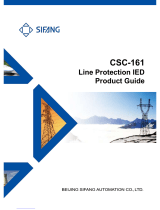
is significantly smaller than the short circuit
currents. In addition to this, the magnitude of
the fault current is almost independent on the
fault location in the network. The protection
can be selected to use either the residual
current or residual power component
3V
0
·3I
0
·cos j, for operating quantity. There is
also available one non-directional 3I
0
step and
one non-directional 3V
0
overvoltage tripping
step.
Thermal overload protection, one
time constant LPTTR (26)
The increasing utilizing of the power system
closer to the thermal limits has generated a
need of a thermal overload protection also for
power lines.
A thermal overload will often not be detected
by other protection functions and the
introduction of the thermal overload protection
can allow the protected circuit to operate closer
to the thermal limits.
The three-phase current measuring protection
has an I
2
t characteristic with settable time
constant and a thermal memory.
An alarm pickup gives early warning to allow
operators to take action well before the line is
tripped.
Breaker failure protection CCRBRF
(50BF)
Breaker failure protection (CCRBRF, 50BF)
ensures fast back-up tripping of surrounding
breakers in case the protected breaker fails to
open. CCRBRF (50BF) can be current based,
contact based, or an adaptive combination of
these two conditions.
Current check with extremely short reset time
is used as check criterion to achieve high
security against unnecessary operation.
Contact check criteria can be used where the
fault current through the breaker is small.
Breaker failure protection (CCRBRF, 50BF)
current criteria can be fulfilled by one or two
phase currents, or one phase current plus
residual current. When those currents exceed
the user defined settings, the function is
activated. These conditions increase the
security of the back-up trip command.
CCRBRF (50BF) function can be programmed
to give a three-phase re-trip of the protected
breaker to avoid unnecessary tripping of
surrounding breakers.
Breaker failure protection CSPRBRF
(50BF)
Breaker failure protection for single pole
tripping applications CSPRBRF (50BF) ensures
fast back-up tripping of surrounding breakers
in case the protected breaker fails to open.
CSPRBRF (50BF) can be current based, contact
based, or adaptive combination between these
two principles.
A current check with extremely short reset time
is used as a check criterion to achieve a high
security against unnecessary operation.
A contact check criteria can be used where the
fault current through the breaker is small.
CSPRBRF (50BF) function current criteria can
be fulfilled by one or two phase currents, or
one phase current plus residual current. When
those currents exceed the user defined settings,
the function is activated. These conditions
increase the security of the back-up trip
command.
CSPRBRF (50BF) can be programmed to give a
three-phase re-trip of the protected breaker to
avoid unnecessary tripping of surrounding
breakers at an incorrect initiation due to
mistakes during testing.
Stub protection STBPTOC (50STB)
When a power line is taken out of service for
maintenance and the line disconnector is
opened, line side voltage transformers will be
Breaker protection REQ650 ANSI 1MRK 505 269-BUS -
Product version: 1.1 Issued: April 2011
ABB 17




















